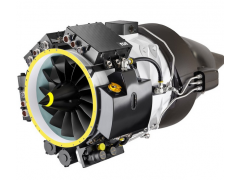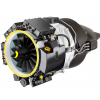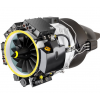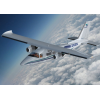DGEN engine
The DGEN engine is the world’s smallest turbofan: it is intended for 4-5 seat twin-engine Personal Light Jets flying under 25,000ft and 250kts.
The DGEN engine has been completely developed and tested in-house by Price Induction’s engineering team. It is recognized by the propulsion community as a mature technology and a great technical success.
DGEN TECHNOLOGY

The DGEN engine is a modern high by-pass ratio turbofan engine which includes great innovations like a geared-down fan and an “all-electric” concept. The DGEN engine is modular, compact, lightweight and easily controlled by FADEC (Full-Authority Digital Engine Control).
The DGEN engine is optimized for a cruise altitude of 10,000ft and Mach 0.35 with a service ceiling at 25,000ft. The DGEN engine is designed with inherent robustness, easy integration and maintainability, low fuel consumption and low noise level. The engine control unit as well as the oil & fuel equipment are fully integrated around the engine.
The DGEN engine family is intended to motorize 4-5 seat Personal Light Jets with a maximum take-off weight of 1650 to 2150kg. For that purpose, the DGEN 380 is the first engine of the DGEN family with 255daN of thrust. The DGEN 390 is a more powerful evolution with 330daN of thrust: it shares 90% of its parts with the DGEN 380.
INSIDE THE DGEN ENGINE

The DGEN engine features a modern and innovative two-spool unmixed flow architecture with a high bypass ratio of 7,6. The gearbox with a 3.32 ratio links the low pressure spool to the fan spool and contributes to the low noise signature and the engine’s compactness.
The “all-electric” concept revolves around the electrical control of the FADEC over electrical oil & fuel pumps. A starter-generator device is integrated on the high-pressure spool and allows for the electrical start of the engine before switching to generation mode. The main advantages are an easy and reliable control for the pilot, simplified maintenance and a reduced overall weight. This concept also allows for a continuous engine health and aging monitoring.
EQUIPMENT & MATERIALS
The DGEN 380’s fuel equipment is designed to operate with Jet A1 fuel with a specific consumption of 0.78 Kg of fuel per kg of thrust per hour at design point. DGEN engines are lubricated and oil-cooled in a closed circuit including in particular the oil tank, fuel-oil and air-oil heat exchangers, a filter and a 4-stage pump.
The DGEN engine uses modern and high-performance materials which are the best compromise between weight reduction, structural and operational requirements: fan and casing in aluminium, exhaust shell in composite, compressor in titanium and hot parts in a nickel alloy.
PERSonAL LIGHT JETS

The DGEN engine enables the development of the Personal Light Jets which are 4-5 seat twin-engine aircraft with a maximum take-off weight of up to 2,500kg. They are intended for private pilots who want to reach 800 to 1100Nm by flying in the General Aviation’s flight domain (under 25,000ft) with high performance levels. Targeted applications include air travel, air taxi and flight training.
Personal Light Jets constitute a niche market combining the perks of both traditional piston engine aircraft (accessibility, cost) and business & corporate jets (safety, performance, comfort).
Personal Light Jets represent a useful and affordable investment for private pilots or small and medium sized corporations. The low maintenance requirements and fuel consumption reduce operating costs compared to entry level business jets and traditional airplanes.
The twin engine configuration ensures maximum safety in the event of an engine failure. DGEN engines will be installed in nacelles, with the air inlet located approximately in line with the trailing edge of the wing. This layout reduces the risks associated with ingestion and clears the airframe from any complex mechanical assemblies, thus making it possible to isolate the cockpit and provide it with crashworthiness greater than the current standards.
Combining a low noise level with short take-off and landing distances, these PLJs will have clearance in all airports commonly used by general aviation airplanes, as opposed to Very Light Jets and other business jets.











